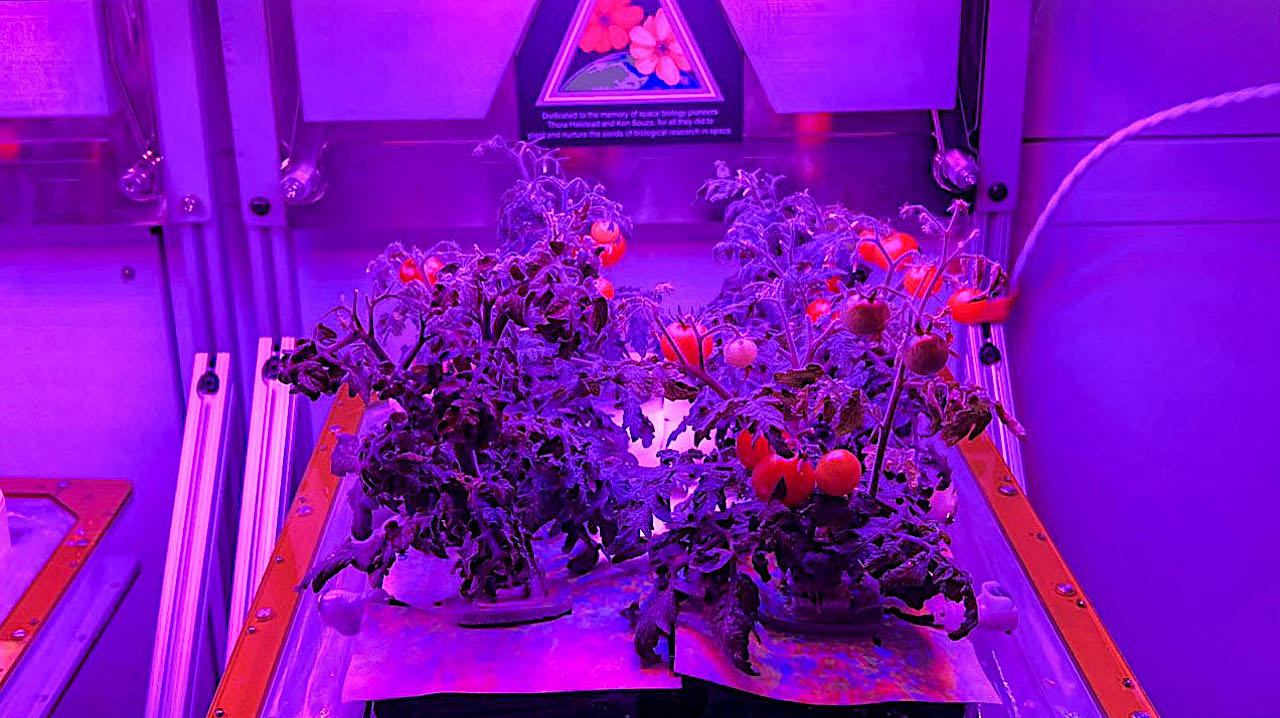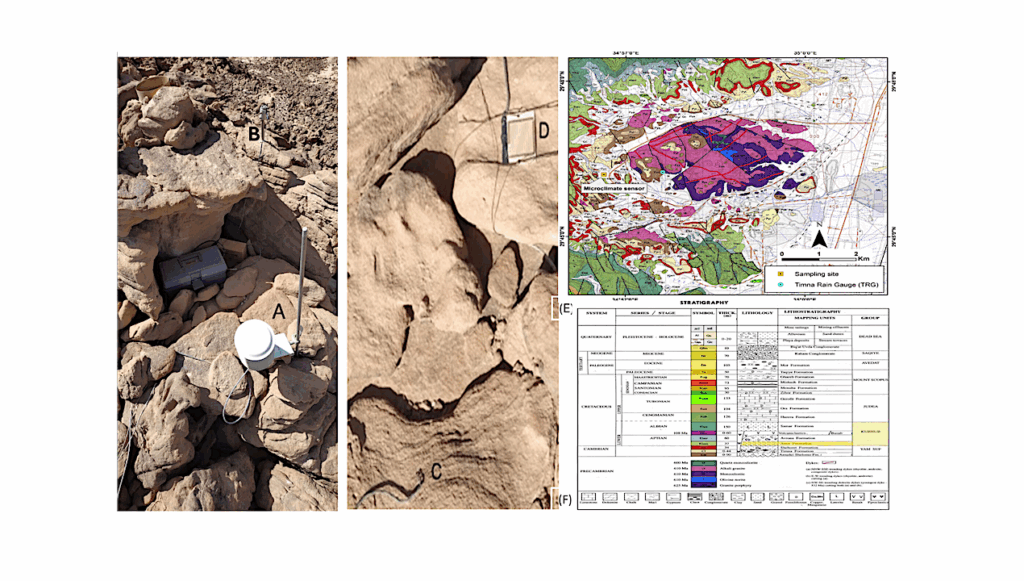NASA Spaceline Current Awareness List #1,074 – 10 November 2023 (Space Life Science Research Results)

A preflight view of Red Robin dwarf tomato growing in growing in Veggie hardware at the Kennedy Space Center – part of Veg-05 experiment.
NASA
SPACELINE Current Awareness Lists are distributed via listserv and are available on the NASA Task Book website at https://taskbook.nasaprs.com/Publication/spaceline.cfm. Please send any correspondence to Shawna Byrd, SPACELINE Current Awareness Senior Editor, [email protected].
This week‘s Current Awareness list is being sent out early due to our office being closed in observance of Veterans Day tomorrow. The next list will be sent out as usual on Friday, November 17.
Papers deriving from NASA support:
- Simpson AC, Sengupta P, Zhang F, Hameed A, Parker CW, Singh NK, Miliotis G, Rekha PD, Raman K, Mason CE, Venkateswaran K.Phylogenomics, phenotypic, and functional traits of five novel (Earth-derived) bacterial species isolated from the International Space Station and their prevalence in metagenomes.Sci Rep. 2023 Nov 6;13:19207.PI: K. VenkateswaranNote: ISS results. This article may be obtained online without charge.
Journal Impact Factor: 4.6
Funding: “Part of the research described in this publication was carried out at the Jet Propulsion Laboratory, California Institute of Technology, under a contract with National Aeronautics and Space Administration (80NM0018D0004). This research was funded by a 2012 Space Biology NNH12ZTT001N grant no. 19-12829-26 under Task Order NNN13D111T award to KV. PS is supported through Prime Minister’s Research Fellowship from the Ministry of Education, Government of India.” - Zwart SR, Macias BR, Laurie SS, Ferguson C, Stern C, Suh A, Melin MM, Young M, Bershad E, Smith SM.Optic disc edema during strict 6° head-down tilt bed rest is related to one-carbon metabolism pathway genetics and optic cup volume.Front Ophthalmol. 2023 Oct 2727;3:1279831.Note: Head-down tilt bedrest study. This article is part of Research Topic “Space Ophthalmology: Assessment, Treatment and Mitigation of Spaceflight Associated Neuroocular Syndrome (SANS)” (https://www.frontiersin.org/research-topics/58922/space-ophthalmology-assessment-treatment-and-mitigation-of-spaceflight-associated-neuroocular-syndrome-sans#overview). The Research Topic also includes an article from previous Current Awareness Lists #1,068 https://doi.org/10.3389/fopht.2023.1229748. Additional articles will be forthcoming and may be found in the link to the Research Topic. This article may be obtained online without charge.
Journal Impact Factor: Not available for this journal
Funding: “We thank Edwin Mulder at DLR for his help obtaining blood samples and leading the implementation of these bed rest studies. We thank Kerry George for technical editing. We thank the NASA Nutritional Biochemistry Lab for their support of the sample and data management and NASA Cardiovascular and Vision Laboratory for analysis of OCT variables.” - Larson H, Stirling L.Examination of human spatial reasoning capability and simulated autonomous rendezvous and docking monitoring performance.Proc Hum Factors Ergon Soc Annu Meet. Oct 25;21695067231192262. Online ahead of print.PI: L. StirlingNote: This article is a meeting proceedings that published in peer-reviewed Sage journals and may be obtained online without charge.
Journal Impact Factor: 3.598
Funding: “This study was supported in part by the National Aeronautics and Space Administration (NASA) Human Research Program Award 80NSSC20K0409.” - Schiller D, Yu ANC, Alia-Klein N, Becker S, Cromwell HC, Dolcos F, Eslinger PJ, Frewen P, Kemp AH, Pace-Schott EF, Raber J, Silton RL, Stefanova E, Williams JHG, Abe N, Aghajani M, Albrecht F, Alexander R, Anders S, Aragón OR, Arias JA, Arzy S, Aue T, Baez S, Balconi M, Ballarini T, Bannister S, Banta MC, Barrett KC, Belzung C, Bensafi M, Booij L, Bookwala J, Boulanger-Bertolus J, Boutros SW, Bräscher AK, Bruno A, Busatto G, Bylsma LM, Caldwell-Harris C, Chan RCK, Cherbuin N, Chiarella J, Cipresso P, Critchley H, Croote DE, Demaree HA, Denson TF, Depue B, Derntl B, Dickson JM, Dolcos S, Drach-Zahavy A, Dubljević O, Eerola T, Ellingsen DM, Fairfield B, Ferdenzi C, Friedman BH, Fu CHY, Gatt JM, deGelder B, Gendolla GHE, Gilam G, Goldblatt H, Gooding AEK, Gosseries O, Hamm AO, Hanson JL, Hendler T, Herbert C, Hofmann SG, Ibanez A, Joffily M, Jovanovic T, Kahrilas IJ, Kangas M, Katsumi Y, Kensinger E, Kirby LAJ, Koncz R, Koster EHW, Kozlowska K, Krach S, Kret ME, Krippl M, Kusi-Mensah K, Ladouceur CD, Laureys S, Lawrence A, Li CR, Liddell BJ, Lidhar NK, Lowry CA, Magee K, Marin MF, Mariotti V, Martin LJ, Marusak HA, Mayer AV, Merner AR, Minnier J, Moll J, Morrison RG, Moore M, Mouly AM, Mueller SC, Mühlberger A, Murphy NA, Muscatello MRA, Musser ED, Newton TL, Noll-Hussong M, Norrholm SD, Northoff G, Nusslock R, Okon-Singer H, Olino TM, Ortner C, Owolabi M, Padulo C, Palermo R, Palumbo R, Palumbo S, Papadelis C, Pegna AJ, Pellegrini S, Peltonen K, Penninx B, Pietrini P, Pinna G, Lobo RP, Polnaszek KL, Polyakova M, Rabinak C, HeleneRichter S, Richter T, Riva G, Rizzo A, Robinson JL, Rosa P, Sachdev PS, Sato W, Schroeter ML, Schweizer S, Shiban Y, Siddharthan A, Siedlecka E, Smith RC, Soreq H, Spangler DP, Stern ER, Styliadis C, Sullivan GB, Swain JE, Urben S, Van den Stock J, Vander Kooij MA, van Overveld M, Van Rheenen TE, VanElzakker MB, Ventura-Bort C, Verona E, Volk T, Wang Y, Weingast LT, Weymar M, Williams C, Willis ML, Yamashita P, Zahn R, Zupan B, Lowe L, Gabriela G, Charlotte FH, Leonie L.The Human Affectome.Neurosci Biobehav Rev. 2023 Nov 3;105450. Review. Online ahead of print.PI: J. Raber; M. Weil, J. Raber/NSCORNote: From the abstract: “In this capstone paper for the special issue ‘Towards an Integrated Understanding of the Human Affectome,’ (https://www.sciencedirect.com/journal/neuroscience-and-biobehavioral-reviews/special-issue/10BBGN98M0M) we gather the tiered purpose of human affective phenomena to synthesize assumptions that account for human affective phenomena collectively. This teleologically-grounded framework offers a principled agenda and launchpad for both organizing existing perspectives and generating new ones.” This article may be obtained online without charge.
Journal Impact Factor: 8.2
Funding: “…J. Raber was supported in part by the United States Department of Defense Grant W81XWH-17- 1-0193, NIH RF1 AG059088, R21 ES027943, R21 AG065914, R01 NS080866 , RF1 AG058273, R01 HL140182, R21 CA223461, U19 AT010829, and by NASA NSCOR NNX15AK13G to M.Weil (OHSU subcontract to J. Raber) and NASA NASA 80NSSC19K0498 –P00001 to J. Baker (subcontract to J. Raber). …” - Narayanan SA, Jamison DA, Jr., Guarnieri JW, Zaksas V, Topper M, Koutnik AP, Park J, Clark KB, Enguita FJ, Leitão AL, Das S, Moraes-Vieira PM, Galeano D, Mason CE, Trovão NS, Schwartz RE, Schisler JC, Coelho-Dos-Reis JGA, Wurtele ES, Beheshti A.A comprehensive SARS-CoV-2 and COVID-19 review, Part 2: Host extracellular to systemic effects of SARS-CoV-2 infection.Eur J Hum Genet. 2023 Nov 8. Review.PIs: S.A. Narayanan, A. BeheshtiNote: Part 1 of this article was included in CA list #1,000 https://pubmed.ncbi.nlm.nih.gov/35577935. This article may be obtained online without charge.
Journal Impact Factor: 5.2
Funding: “This work was supported by supplemental funds for COVID-19 research from Translational Research Institute of Space Health through NASA Cooperative Agreement NNX16AO69A (T-0404) to AB, and by a NASA Space Biology Postdoctoral Fellowship (80NSSC19K0426) and Human Research Program Augmentation Award (80NSSC19K1322) to SAN.” - Li M, Noejovich SI, Cross EV, Lee JD.Explaining trust divergence: Bifurcations in a dynamic system.Proc Hum Factors Ergon Soc Annu Meet. Oct 25;21695067231192294. Online ahead of print.PI: J.D. LeeNote: This article is a meeting proceedings that published in peer-reviewed Sage journals and may be obtained online without charge.
Journal Impact Factor: 3.598
Funding: “This work was supported by NASA Human Research Program No.80NSSC19K0654.” - Daniels VR, Williams ES.Exploring the complexities of drug formulation selection, storage, and shelf-Life for exploration spaceflight.Br J Clin Pharmacol. 2023 Nov 8. Review. Online ahead of print.Journal Impact Factor: 3.4
Funding: E.S. Williams is affiliated with NASA Johnson Space Center. - Tang J, Weiss H, Stirling L.A comparison of sensorimotor assessment accuracy between augmented reality and touchscreen environments.PI: L. StirlingNote: This article appeared in last week’s list in the “Other” section. It is appearing this week in the “NASA” section along with the PI and funding information. This article is a meeting proceedings that published in peer-reviewed Sage journals and may be obtained online without charge.
Journal Impact Factor: 3.598
Funding: “This study was supported in part by the National Aeronautics and Space Administration (NASA) Human Research Program Award 80NSSC20K0409.”
Other papers of interest:
- Landry KS, Young E, Avery TS, Gropman J.Efficacy of a novel SPF booster based on research aboard the International Space Station.Cosmetics. 2023 Oct 2;10(5):138.Note: ISS results. This article is part of Special Issue “Bioactive Compounds From Natural Resources Against Skin Aging” (https://www.mdpi.com/journal/cosmetics/special_issues/5M9433ER7K). Additional articles will be forthcoming and may be found in the link to the Special Issue. This article may be obtained online without charge.
- Wakayama S, Kikuchi Y, Soejima M, Hayashi E, Ushigome N, Yamazaki C, Suzuki T, Shimazu T, Yamamori T, Osada I, Sano H, Umehara M, Hasegawa A, Mochida K, Yang LL, Emura R, Kazama K, Imase K, Kurokawa Y, Sato Y, Higashibata A, Matsunari H, Nagashima H, Ogura A, Kohda T, Wakayama T.Effect of microgravity on mammalian embryo development evaluated at the International Space Station.iScience. 2023 Oct 27. Online ahead of print.Note: ISS results. This article may be obtained online without charge.
- Yin Y, Liu J, Fan Q, Zhao S, Wu X, Wang J, Liu Y, Li Y, Lu W.Long-term spaceflight composite stress induces depression and cognitive impairment in astronauts—Insights from neuroplasticity.Transl Psychiatry. 2023 Nov 8;13:342. Review.Note: This article may be obtained online without charge.
- Mahalmani V, Medhi B.Space medicine: Hunting for pharmacologist’s guide in dealing with drugs in microgravity.Indian J Pharmacol. 2023 Sep-Oct;55(5):281-5.Note: This is an editorial to the Special Issue found in the above link.
- Sventitskaya MA, Ogneva IV.Reorganization of the mouse oocyte cytoskeleton after cultivation under simulated weightlessness.Life Sci Space Res. 2023 Nov 4. Online ahead of print.Note: From the abstract: “Female germ cells provide the structural basis for the development of a new organism, while the main molecular mechanisms of the impact of weightlessness on the cell remain unknown. The aim of this work was to determine the relative content and distribution of the main proteins of microtubules and microfilaments, to assess the relative RNA content of genes in mouse oocytes after short-term exposure to simulated microgravity, and to determine the potential for embryo development up to the 3-cell stage.”
- Green MJ, Murray EJ, Williams P, Ghaemmaghami AM, Aylott JW, Williams PM.Modelled-microgravity reduces virulence factor production in Staphylococcus aureus through downregulation of agr-dependent quorum sensing.Int J Mol Sci. 2023 Nov 6;24(21):15997.Note: This article is part of Special Issue “Cellular and Molecular Signaling Meet the Space Environment 2.0” (https://www.mdpi.com/journal/ijms/special_issues/NG6NTA62OE). The Special Issue includes articles from Current Awareness lists #1,034 https://doi.org/10.3390/ijms24021540; #1,048 https://doi.org/10.3390/ijms24087656; 1,058 https://doi.org/10.3390/ijms241311135; #1,064 https://doi.org/10.3390/ijms241612640; and #1,065 https://doi.org/10.3390/ijms241713569 and https://doi.org/10.3390/ijms241713604. This article may be obtained online without charge.
- Li W, Yu Y, Zhou G, Hu G, Li B, Ma H, Yan W, Pei H.Large-scale ORF screening based on LC-MS to discover novel lncRNA-encoded peptides responding to ionizing radiation and microgravity.Comput Struct Biotechnol J. 2023 Oct 19;21:5201-11.Note: This article may be obtained online without charge.
- Walsh L, Hafner L, Berger T, Matthiä D, Schneider U, Straube U.European astronaut radiation related cancer risk assessment using dosimetric calculations of organ dose equivalents.Z Med Phys. 2023 Nov 4. Online ahead of print.
- Todd KL, Lai J, Sek K, Huang YK, Newman DM, Derrick EB, Koay HF, Nguyen D, Hoang TX, Petley EV, Chan CW, Munoz I, House IG, Lee JN, Kim JS, Li J, Tong J, M NdM, Scheffler CM, Yap KM, Chen AXY, Dunbar PA, Haugen B, Parish IA, Johnstone RW, Darcy PK, Beavis PA.A2AR eGFP reporter mouse enables elucidation of A2AR expression dynamics during anti-tumor immune responses.Nat Commun. 2023 Nov 1;14:6990.Note: This article may be obtained online without charge.
- Saloň A, Çiftci GM, Zubac D, Šimunič B, Pišot R, Narici M, Fredriksen PM, Nkeh-Chungag BN, Sourij H, Šerý O, Schmid-Zalaudek K, Steuber B, De Boever P, Goswami N.Retinal venular vessel diameters are smaller during ten days of bedrest.Sci Rep. 2023 Nov 7;13(1):19258.Note: This article may be obtained online without charge.
Astrobiology








